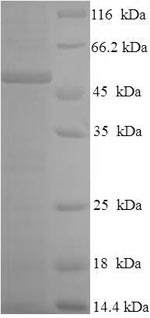Experience the exceptional quality of our Recombinant Human CSF2RA, expertly designed for optimal performance in immunology research. This product features the extracellular domain of Granulocyte-macrophage colony-stimulating factor receptor subunit alpha (GM-CSF-R-alpha, GMCSFR-alpha, GMR-alpha, CD116), an important protein involved in immune system regulation and hematopoietic cell proliferation and differentiation.
Sourced from E.coli, the Recombinant Human CSF2RA encompasses an expression region of 23-320 amino acids and includes an N-terminal 6xHis-SUMO tag for seamless purification and detection. With a purity greater than 90% as determined by SDS-PAGE, our product is available in both liquid and lyophilized powder formats to accommodate your research needs. Choose the precision-engineered Recombinant Human CSF2RA to advance your immunology research with confidence and reliability.






